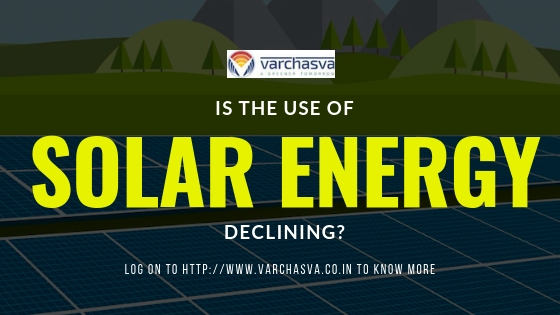- Events
- >
- Single Events
Varchasva Energy Pvt. Ltd.
- Varchasva energy is well equipped with qualified energy professionals with a collective experience of over 10 years. We are a team of solar enthusiasts with technological innovations underlining the focus on quality services and all round support. Varchasva takes on charge and commitment towards the development of eco-friendly technologies with innovative and futuristic energy solution. We, at Varchasva, recognize the importance of every step taken towards building a greener and safer future. By harnessing the inexhaustible energy of the sun, we offer efficient and advanced solutions for energy requirements for today and tomorrow.
Inquiry Now


Varchasva Energy Pvt. Ltd.
Posted on : 18 Apr 2024 03 : 08 : 46 am
By : vaibhav.ujjain@varchasva.co.in
Is The Use Of Solar Energy Declining In India?
If yes, how can we stem the tide and reverse the trend? There was a recent statistic which mentions that the use of solar energy declined by 52% in India in 2017. The reason for this is not difficult to guess. A steep 25% safeguard duty imposed on imports of solar panel cells from China and Malaysia, has a lot to do with this retrogressive trend. The government’s logic is that safeguard duty will protect the interest of domestic manufacturers. However, as of now, India has only six manufacturers of solar modules. With a total capacity of 3000 MW, there is no way these six can adequately meet the increasing demand for solar power in the country of the size of India. On the contrary, with this duty, there is surely going to be a reduction in the number of bidders for solar projects in India. Another reason for the decline in the use of solar power in India is the GST slab set for the solar module manufacturing industry. Manufacturers now have to pay a steeper GST for raw material procurement, not to forget the difference in the GST rates for various components (5% GST on solar modules, 18% on inverters, and 28% on batteries) leading to more confusion and chaos in the industry. Meanwhile, to make matters worse, the global rise in the price of photovoltaic modules has impacted solar development projects in India. Indeed, bidders in India were waiting for a different announcement - the decline in prices of the Chinese module. Now with the rise in Chinese pricing, bidders have stacking have started pulling back. Add to this, the anti-dumping duties imposed by the domestic manufacturers, which has further subdued bidding activity. As things stand, about 60 percent of the electricity in India is supplied by coal-fired power stations. This output is not just inefficient but also highly polluting. Although the PM has pledged to build a capacity of 100 GW of solar power by 2022, considering the decrease in the momentum, this goal seems like a pipe dream, now. A 100% renewable mix can be reached only by overcoming challenges such as land availability and availability of a comprehensive and reliable transmission grid. There is also the energy storage issue that needs to be looked into. In its attempt to step-up the use of solar energy, the Modi Government has started urging big power consumers to increase their share of renewables in their overall energy mix. From the current level of 17%, the renewable purchase obligation (RPO) target has to go up to 21% by 2022. This difficult target is set for the power distribution companies of the states, as well as a few private firms. All these entities will have to start fulfilling 10.5% of their total electricity requirements from solar sources and another 10.5% from other non-solar renewable sources. Hopefully, all these steps taken together, with a long-term vision for growth, will increase the consumption of solar energy in India, and eventually reduce our dependence on coal